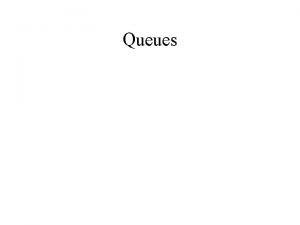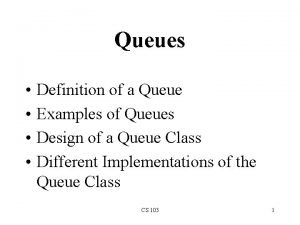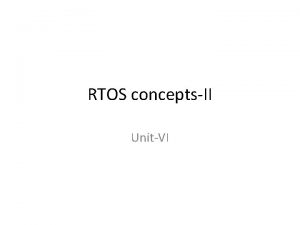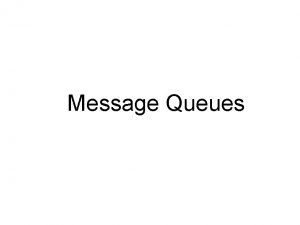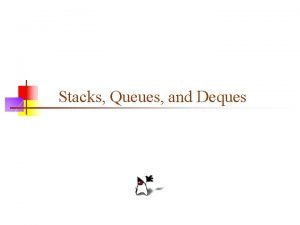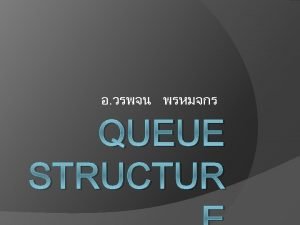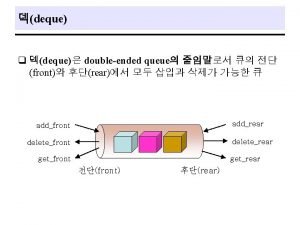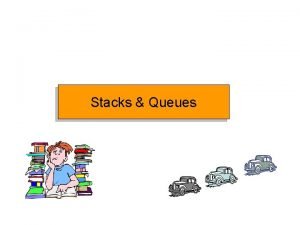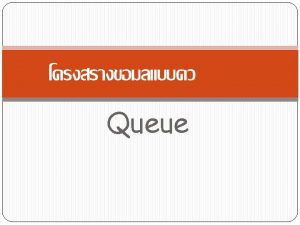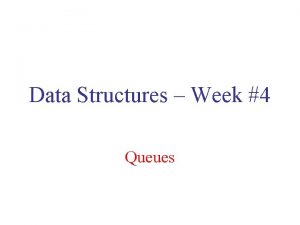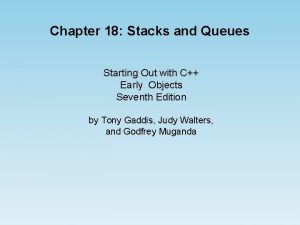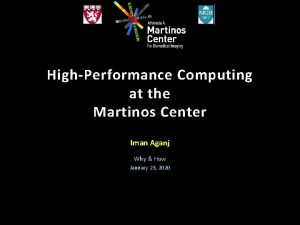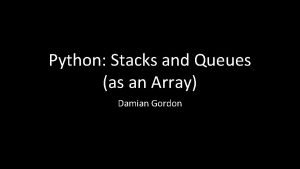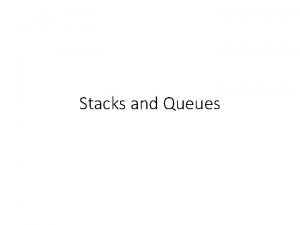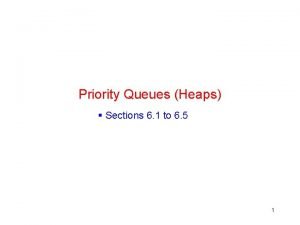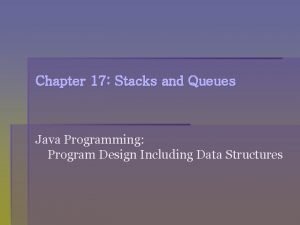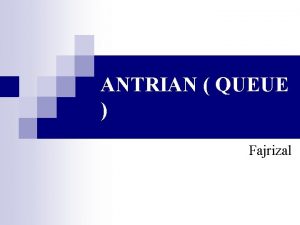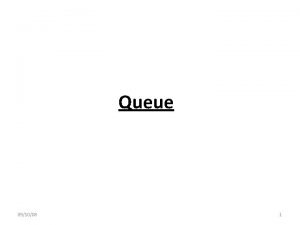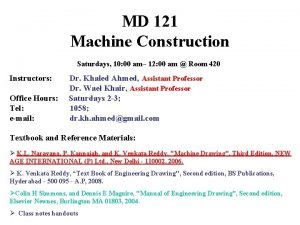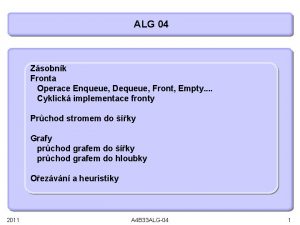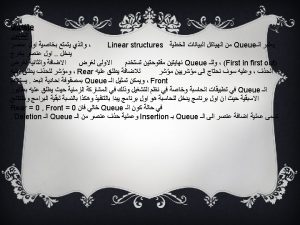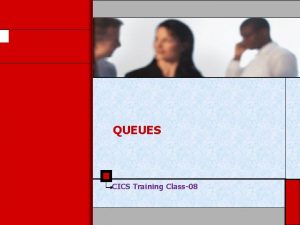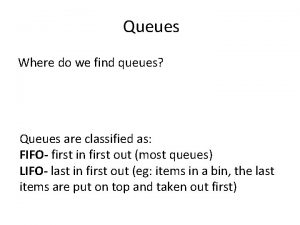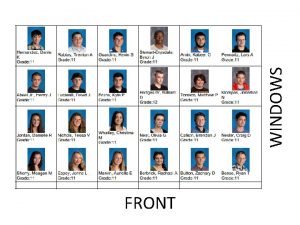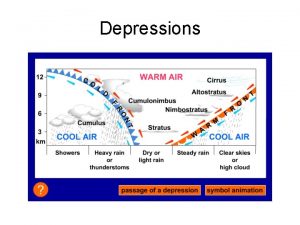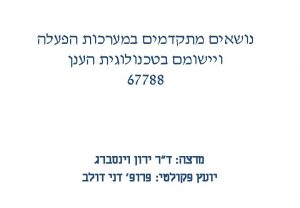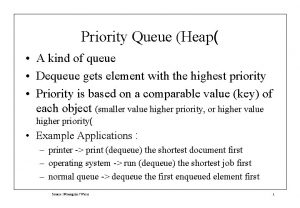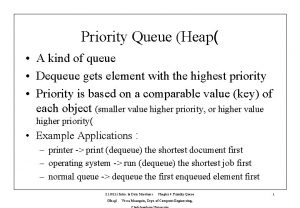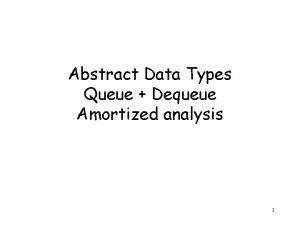Queues front rear dequeue enqueue Message queues in

































- Slides: 33

Queues

front rear … … dequeue enqueue






Message queues in an operating system There are times that programs need to communicate with each other. Unix operating system provides message queue as one of the mechanisms to facilitate communication. Send a message to the queue Program #1 rear front Take a message from the queue Program #2






The Queue Abstract Data Type


This table shows a series of queue operations and their effects. The queue is empty initially. 5 3


A Queue Interface in Java

A Simple Array-Based Implementation To implement a queue with an array, we need: 1. An array of the size N 2. An index f for the front element 3. An index r for next empty slot or cell Q: 0 1 2 … f r N-1

As objects are enqueued and dequeued, the queue moves along in the array. For example: After enqueue: After dequeue: f r r f f r


When we increment f or r, we compute the result as (f + 1) mod N or (r + 1) mod N. In Java, the modulo operator is % (remainder operator). For example, if r = N - 1, then (r + 1) = N , therefore, (r + 1) mod N = 0 The value of r wraps around from N to 0. Q: 0 1 2 N - 1 … r f

Initially, we assign r = f = 0, indicating that the queue is empty. During the process, we may meet a situation where r = f = i (0 < i < N), which also indicates the queue is empty. Now we assume that we enqueue N objects into Q without dequeueing any of them: Q: 0 1 2 N - 1 … f r Then, we have r = f = 0. But in this case, we have a full queue. In general, when r = f = i (0 < i < N), it is possible that we have a full queue.

Problem: r = f may indicate that the queue is empty or that the queue is full. Solution: when |r – f| = N – 1, report that the queue is full.

Algorithms: size(): return the number (N - f + r) mod N 0 1 2 If r f, then r - f 0 N-1 N+r-1 N + (r - f ) N (N - f + r) mod N = - f + r = r - f If r < f, then f - r > 0 N - f + r = N – (f - r ) < N (N - f + r) mod N = N - f + r

Algorithms: is. Empty( ): return the result of the evaluation of the relationship f = r f r

Algorithms: front( ): if the queue is empty throw a Queue. Empty. Exception else return element Q[f] Q: 0 1 2 … f r N-1

enqueue(o): if queue size is N - 1 throw a Queue. Full. Exception else store the object to Q[r] assign (r + 1) mod N to r (r + 1) mod N Q: 0 1 2 … f r N-1

dequeue( ): if queue size is empty throw a Queue. Empty. Exception else save the element Q[f] to a variable temp make the element Q[f] a null object assign (f + 1) mod N to f (f + 1) mod N Q: 0 1 2 … f r N-1

Memory Allocation in Java



Data Structure Exercises 4. 1
 Queue front rear
Queue front rear Definition of queue
Definition of queue I automobile
I automobile Message queues in rtos
Message queues in rtos Message queues in unix
Message queues in unix What is a dequeue
What is a dequeue Queue front
Queue front Queue front rear
Queue front rear Enqueue
Enqueue Enqueue
Enqueue Enqueue
Enqueue Enqueue
Enqueue Java stack exercises
Java stack exercises Mgh
Mgh Cqueue
Cqueue Adaptable priority queues
Adaptable priority queues What are stacks
What are stacks Priority queues: quiz
Priority queues: quiz Applications of priority queues
Applications of priority queues Representation of queues
Representation of queues Java stacks and queues
Java stacks and queues Jenis jenis queue
Jenis jenis queue Office operations
Office operations Dead front vs live front transformer
Dead front vs live front transformer Draw a warm front
Draw a warm front Front cover page for school magazine
Front cover page for school magazine Linear vs circular queue
Linear vs circular queue The soldier poem meaning
The soldier poem meaning Rear axle construction
Rear axle construction Rear window dancer
Rear window dancer The flag should be in the rear of a procession and centered
The flag should be in the rear of a procession and centered Federal seat belt law
Federal seat belt law Orthographic projection
Orthographic projection Chapter 75
Chapter 75
